Machine Learning-Based Flood Risk Assessment in Urban Watershed: Mapping Flood Susceptibility in Charlotte, North Carolina
Abstract
1. Introduction
- Examining the influence of hydrological and geomorphological factors on flood susceptibility in the Briar Creek watershed.
- Evaluating the predictive performance of various machine learning algorithms—including bagging, logistic regression, and XGBoost—to identify the most suitable model for flood risk assessment in the Briar Creek watershed.
- Producing a detailed flood susceptibility map of the Briar Creek watershed to support urban flood management, disaster preparedness, and policymaking.
2. Study Area
3. Materials and Methods
3.1. Data Acquisition and Processing
3.2. Machine Learning Model Selection
3.3. Hyperparameter Tuning (Grid SearchCV)
4. Results and Discussions
4.1. Correlation Analysis of Flood Conditioning Factors
4.2. Performance Metrics of Machine Learning Models
4.3. ROC Curve Interpretation
4.4. Feature Importance for Machine Learning Models
4.5. Flood Risk Susceptibility Map
4.6. Limitations and Potential Directions for Future Research
5. Conclusions
Author Contributions
Funding
Data Availability Statement
Acknowledgments
Conflicts of Interest
References
- Islam, M.Z.; Wang, C. Cost of High-Level Flooding as a Consequence of Climate Change Driver?: A Case Study of China’s Flood-Prone Regions. Ecol. Indic. 2024, 160, 111944. [Google Scholar] [CrossRef]
- Dahal, D.; Shrestha, S.; Poudel, B.; Banjara, M.; Kalra, A. The Role of Reclaimed Water in Urban Flood Management: Public Perception and Acceptance. Earth Sci. Res. 2025, 14, 1. [Google Scholar] [CrossRef]
- Teku, D.; Eshetu, S. Impact of Climatic Variabilities and Extreme Incidences on the Physical Environment, Public Health, and People’s Livelihoods in Ethiopia. Front. Clim. 2024, 6, 1435138. [Google Scholar] [CrossRef]
- Ruan, X.; Sun, H.; Shou, W.; Wang, J. The Impact of Climate Change and Urbanization on Compound Flood Risks in Coastal Areas: A Comprehensive Review of Methods. Appl. Sci. 2024, 14, 10019. [Google Scholar] [CrossRef]
- Mucherera, B.; Spiegel, S. Forced Displacement: Critical Lessons in the Protracted Aftermath of a Flood Disaster. GeoJournal 2022, 87, 3855–3875. [Google Scholar] [CrossRef]
- Nguyen, H.N.; Fukuda, H.; Nguyen, M.N. Assessment of the Susceptibility of Urban Flooding Using GIS with an Analytical Hierarchy Process in Hanoi, Vietnam. Sustainability 2024, 16, 3934. [Google Scholar] [CrossRef]
- Swain, K.C.; Singha, C.; Nayak, L. Flood Susceptibility Mapping through the GIS-AHP Technique Using the Cloud. ISPRS Int. J. Geo-Inf. 2020, 9, 720. [Google Scholar] [CrossRef]
- Hammami, S.; Zouhri, L.; Souissi, D.; Souei, A.; Zghibi, A.; Marzougui, A.; Dlala, M. Application of the GIS Based Multi-Criteria Decision Analysis and Analytical Hierarchy Process (AHP) in the Flood Susceptibility Mapping (Tunisia). Arab. J. Geosci. 2019, 12, 653. [Google Scholar] [CrossRef]
- Fletcher, T.D.; Andrieu, H.; Hamel, P. Understanding, Management and Modelling of Urban Hydrology and Its Consequences for Receiving Waters: A State of the Art. Adv. Water Resour. 2013, 51, 261–279. [Google Scholar] [CrossRef]
- Tehrany, M.S.; Pradhan, B.; Jebur, M.N. Spatial Prediction of Flood Susceptible Areas Using Rule Based Decision Tree (DT) and a Novel Ensemble Bivariate and Multivariate Statistical Models in GIS. J. Hydrol. 2013, 504, 69–79. [Google Scholar] [CrossRef]
- Dahal, D.; Magar, B.A.; Aryal, A.; Poudel, B.; Banjara, M.; Kalra, A. Analyzing Climate Dynamics and Developing Machine Learning Models for Flood Prediction in Sacramento, California. Hydroecol. Eng. 2024, 1, 10003. [Google Scholar] [CrossRef]
- Jahanbani, M.; Vahidnia, M.H.; Aghamohammadi, H.; Azizi, Z. Flood Susceptibility Mapping through Geoinformatics and Ensemble Learning Methods, with an Emphasis on the AdaBoost-Decision Tree Algorithm, in Mazandaran, Iran. Earth Sci. Inform. 2024, 17, 1433–1457. [Google Scholar] [CrossRef]
- Zahraoui, Y.; Korõtko, T.; Rosin, A.; Mekhilef, S.; Seyedmahmoudian, M.; Stojcevski, A.; Alhamrouni, I. AI Applications to Enhance Resilience in Power Systems and Microgrids—A Review. Sustainability 2024, 16, 4959. [Google Scholar] [CrossRef]
- Sadkou, S.; Artigue, G.; Fréalle, N.; Ayral, P.; Pistre, S.; Sauvagnargues, S.; Johannet, A. A Review of Flash-floods Management: From Hydrological Modeling to Crisis Management. J. Flood Risk Manag. 2024, 17, e12999. [Google Scholar] [CrossRef]
- Mosavi, A.; Ozturk, P.; Chau, K. Flood Prediction Using Machine Learning Models: Literature Review. Water 2018, 10, 1536. [Google Scholar] [CrossRef]
- Tehrany, M.S.; Pradhan, B.; Mansor, S.; Ahmad, N. Flood Susceptibility Assessment Using GIS-Based Support Vector Machine Model with Different Kernel Types. CATENA 2015, 125, 91–101. [Google Scholar] [CrossRef]
- Shahabi, H.; Shirzadi, A.; Ghaderi, K.; Omidvar, E.; Al-Ansari, N.; Clague, J.J.; Geertsema, M.; Khosravi, K.; Amini, A.; Bahrami, S.; et al. Flood Detection and Susceptibility Mapping Using Sentinel-1 Remote Sensing Data and a Machine Learning Approach: Hybrid Intelligence of Bagging Ensemble Based on K-Nearest Neighbor Classifier. Remote Sens. 2020, 12, 266. [Google Scholar] [CrossRef]
- Hoang, D.-V.; Liou, Y.-A. Elevating Flash Flood Prediction Accuracy: A Synergistic Approach with PSO and GA Optimization. Nat. Hazards Earth Syst. Sci. 2024, 2024, 1–26. [Google Scholar]
- Costache, R.; Tien Bui, D. Spatial Prediction of Flood Potential Using New Ensembles of Bivariate Statistics and Artificial Intelligence: A Case Study at the Putna River Catchment of Romania. Sci. Total Environ. 2019, 691, 1098–1118. [Google Scholar] [CrossRef]
- Oliva, A.; Olcina, J. Historical Floods and Territorial Planning: Lessons Learned and Opportunities Lost after the Santa Teresa Flood (1879) in the Segura Basin (Spain). Land 2023, 13, 28. [Google Scholar] [CrossRef]
- Gizzi, F.T.; Bovolin, V.; Villani, P.; Potenza, M.R.; Voria, S.; Amodio, A.M. Rewinding the Tape: Documentary Heritage to (Re)Discover “Lost” Natural Hazards—Evidence and Inferences from Southern Italy. Sustainability 2024, 16, 2789. [Google Scholar] [CrossRef]
- Shrestha, S.; Dahal, D.; Poudel, B.; Banjara, M.; Kalra, A. Flood Susceptibility Analysis with Integrated Geographic Information System and Analytical Hierarchy Process: A Multi-Criteria Framework for Risk Assessment and Mitigation. Water 2025, 17, 937. [Google Scholar] [CrossRef]
- Kalra, A.; Shrestha, S.; Dahal, D.; Banjara, M.; Paudel, B.; Gupta, R. Assessing the Performance of HEC-HMS and SWMM Models for Rainfall–Runoff Simulation for Urban Watershed. In Proceedings of the World Environmental and Water Resources Congress 2025, Anchorage, Alaska, 18–21 May 2025; pp. 1230–1242. [Google Scholar] [CrossRef]
- Buchholz, T.A.; Madary, D.A.; Bork, D.; Younos, T. Stream restoration in urban environments: Concept, design principles, and case studies of stream daylighting. In Sustainable Water Management in Urban Environments; Younos, T., Parece, T.E., Eds.; Springer International Publishing: Cham, Switzerland, 2016; pp. 121–165. ISBN 978-3-319-29337-0. [Google Scholar]
- Shrestha, B.; Rajbhandari, E.; Kayastha, R.B.; Shrestha, S.; Dahal, D. Assessing Flood Susceptibility and Frequency Analysis in Himalayan River Basins: A GIS-Based Multi-Criteria Approach. Kathmandu Univ. J. Sci. Eng. Technol. 2025, 19. [Google Scholar] [CrossRef]
- Vojtek, M.; Vojteková, J. Flood Susceptibility Mapping on a National Scale in Slovakia Using the Analytical Hierarchy Process. Water 2019, 11, 364. [Google Scholar] [CrossRef]
- Chen, Y.; Liu, R.; Barrett, D.; Gao, L.; Zhou, M.; Renzullo, L.; Emelyanova, I. A Spatial Assessment Framework for Evaluating Flood Risk under Extreme Climates. Sci. Total Environ. 2015, 538, 512–523. [Google Scholar] [CrossRef]
- Thomson, H.; Zeff, H.B.; Kleiman, R.; Sebastian, A.; Characklis, G.W. Systemic Financial Risk Arising From Residential Flood Losses. Earth’s Future 2023, 11, e2022EF003206. [Google Scholar] [CrossRef]
- Mogollón, B.; Frimpong, E.A.; Hoegh, A.B.; Angermeier, P.L. Recent Changes in Stream Flashiness and Flooding, and Effects of Flood Management in North Carolina and Virginia. JAWRA J. Am. Water Resour. Assoc. 2016, 52, 561–577. [Google Scholar] [CrossRef]
- National Risk Index. Available online: https://hazards.fema.gov/nri/ (accessed on 7 May 2025).
- Zhou, Z.; Smith, J.A.; Yang, L.; Baeck, M.L.; Chaney, M.; Ten Veldhuis, M.; Deng, H.; Liu, S. The Complexities of Urban Flood Response: Flood Frequency Analyses for the Charlotte Metropolitan Region. Water Resour. Res. 2017, 53, 7401–7425. [Google Scholar] [CrossRef]
- Kaya, C.M.; Derin, L. Parameters and Methods Used in Flood Susceptibility Mapping: A Review. J. Water Clim. Chang. 2023, 14, 1935–1960. [Google Scholar] [CrossRef]
- Lee, S.; Rezaie, F. Data Used for GIS-Based Flood Susceptibility Mapping. GEO DATA 2022, 4, 1–15. [Google Scholar] [CrossRef]
- Alkhasawneh, M.S.; Ngah, U.K.; Tay, L.T.; Mat Isa, N.A.; Al-batah, M.S. Determination of Important Topographic Factors for Landslide Mapping Analysis Using MLP Network. Sci. World J. 2013, 2013, 415023. [Google Scholar] [CrossRef]
- Yariyan, P.; Avand, M.; Abbaspour, R.A.; Torabi Haghighi, A.; Costache, R.; Ghorbanzadeh, O.; Janizadeh, S.; Blaschke, T. Flood Susceptibility Mapping Using an Improved Analytic Network Process with Statistical Models. Geomat. Nat. Hazards Risk 2020, 11, 2282–2314. [Google Scholar] [CrossRef]
- Avand, M.; Moradi, H.; Lasboyee, M.R. Using Machine Learning Models, Remote Sensing, and GIS to Investigate the Effects of Changing Climates and Land Uses on Flood Probability. J. Hydrol. 2021, 595, 125663. [Google Scholar] [CrossRef]
- El-Haddad, B.A.; Youssef, A.M.; Pourghasemi, H.R.; Pradhan, B.; El-Shater, A.-H.; El-Khashab, M.H. Flood Susceptibility Prediction Using Four Machine Learning Techniques and Comparison of Their Performance at Wadi Qena Basin, Egypt. Nat. Hazards 2021, 105, 83–114. [Google Scholar] [CrossRef]
- Lee, J.-Y.; Kim, J.-S. Detecting Areas Vulnerable to Flooding Using Hydrological-Topographic Factors and Logistic Regression. Appl. Sci. 2021, 11, 5652. [Google Scholar] [CrossRef]
- El-Rawy, M.; Elsadek, W.M.; De Smedt, F. Flash Flood Susceptibility Mapping in Sinai, Egypt Using Hydromorphic Data, Principal Component Analysis and Logistic Regression. Water 2022, 14, 2434. [Google Scholar] [CrossRef]
- Kim, Y.-O.; Seo, S.B.; Jang, O.-J. Flood Risk Assessment Using Regional Regression Analysis. Nat. Hazards 2012, 63, 1203–1217. [Google Scholar] [CrossRef]
- Cao, Y.; Jia, H.; Xiong, J.; Cheng, W.; Li, K.; Pang, Q.; Yong, Z. Flash Flood Susceptibility Assessment Based on Geodetector, Certainty Factor, and Logistic Regression Analyses in Fujian Province, China. ISPRS Int. J. Geo-Inf. 2020, 9, 748. [Google Scholar] [CrossRef]
- Yariyan, P.; Janizadeh, S.; Van Phong, T.; Nguyen, H.D.; Costache, R.; Van Le, H.; Pham, B.T.; Pradhan, B.; Tiefenbacher, J.P. Improvement of Best First Decision Trees Using Bagging and Dagging Ensembles for Flood Probability Mapping. Water Resour. Manag. 2020, 34, 3037–3053. [Google Scholar] [CrossRef]
- Zanotti, C.; Rotiroti, M.; Sterlacchini, S.; Cappellini, G.; Fumagalli, L.; Stefania, G.A.; Nannucci, M.S.; Leoni, B.; Bonomi, T. Choosing between Linear and Nonlinear Models and Avoiding Overfitting for Short and Long Term Groundwater Level Forecasting in a Linear System. J. Hydrol. 2019, 578, 124015. [Google Scholar] [CrossRef]
- Ren, H.; Pang, B.; Bai, P.; Zhao, G.; Liu, S.; Liu, Y.; Li, M. Flood Susceptibility Assessment with Random Sampling Strategy in Ensemble Learning (RF and XGBoost). Remote Sens. 2024, 16, 320. [Google Scholar] [CrossRef]
- Friedman, J.H.; Hastie, T.; Tibshirani, R. Regularization Paths for Generalized Linear Models via Coordinate Descent. J. Stat. Softw. 2010, 33, 1–22. [Google Scholar] [CrossRef]
- Freund, Y.; Schapire, R.E. A Decision-Theoretic Generalization of On-Line Learning and an Application to Boosting. J. Comput. Syst. Sci. 1997, 55, 119–139. [Google Scholar] [CrossRef]
- Breiman, L. Bagging Predictors. Mach. Learn. 1996, 24, 123–140. [Google Scholar] [CrossRef]
- Beven, K.J. Rainfall-Runoff Modelling: The Primer; John Wiley & Sons: Hoboken, NJ, USA, 2012; ISBN 978-0-470-71459-1. [Google Scholar]
- Zounemat-Kermani, M.; Batelaan, O.; Fadaee, M.; Hinkelmann, R. Ensemble Machine Learning Paradigms in Hydrology: A Review. J. Hydrol. 2021, 598, 126266. [Google Scholar] [CrossRef]
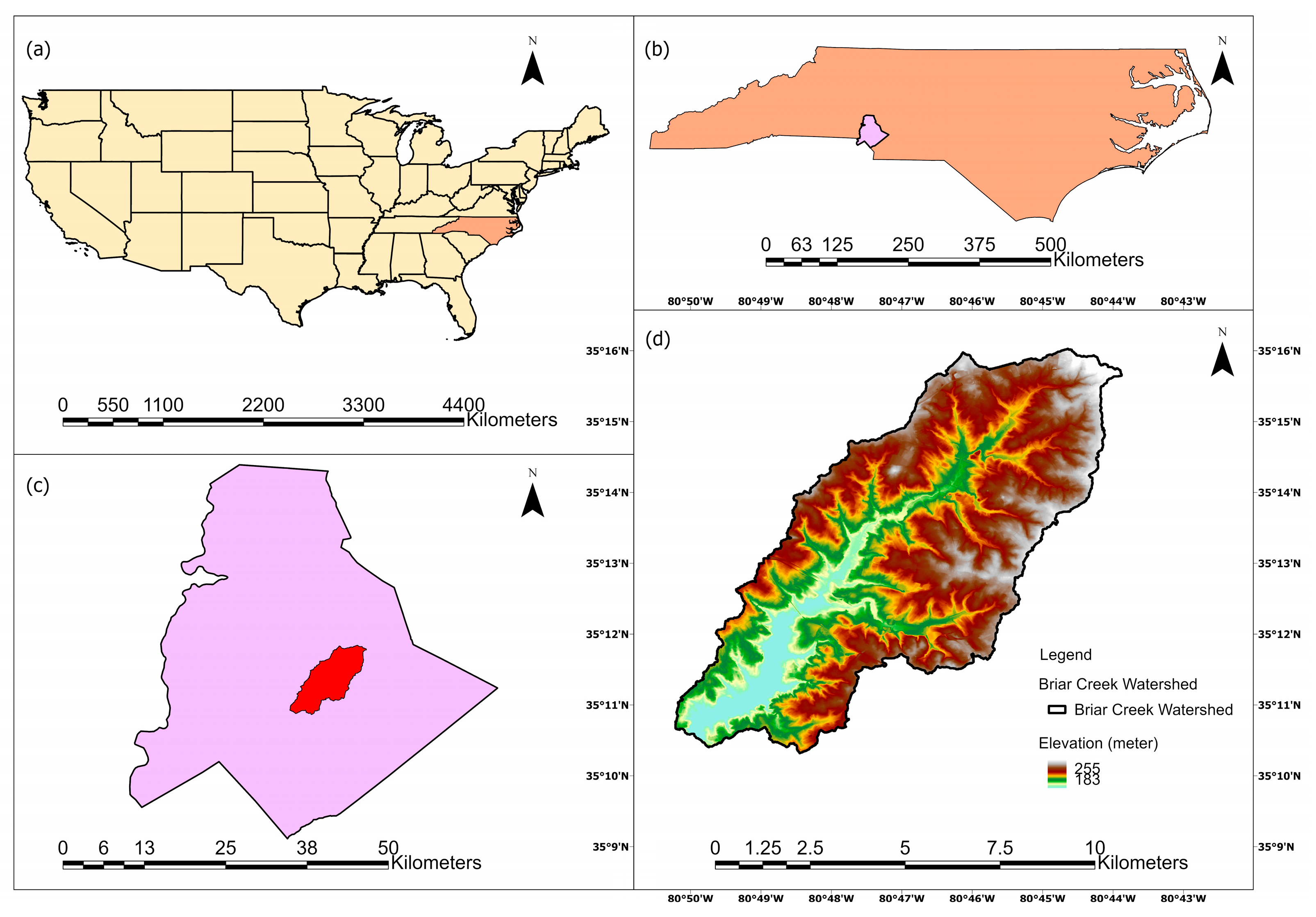
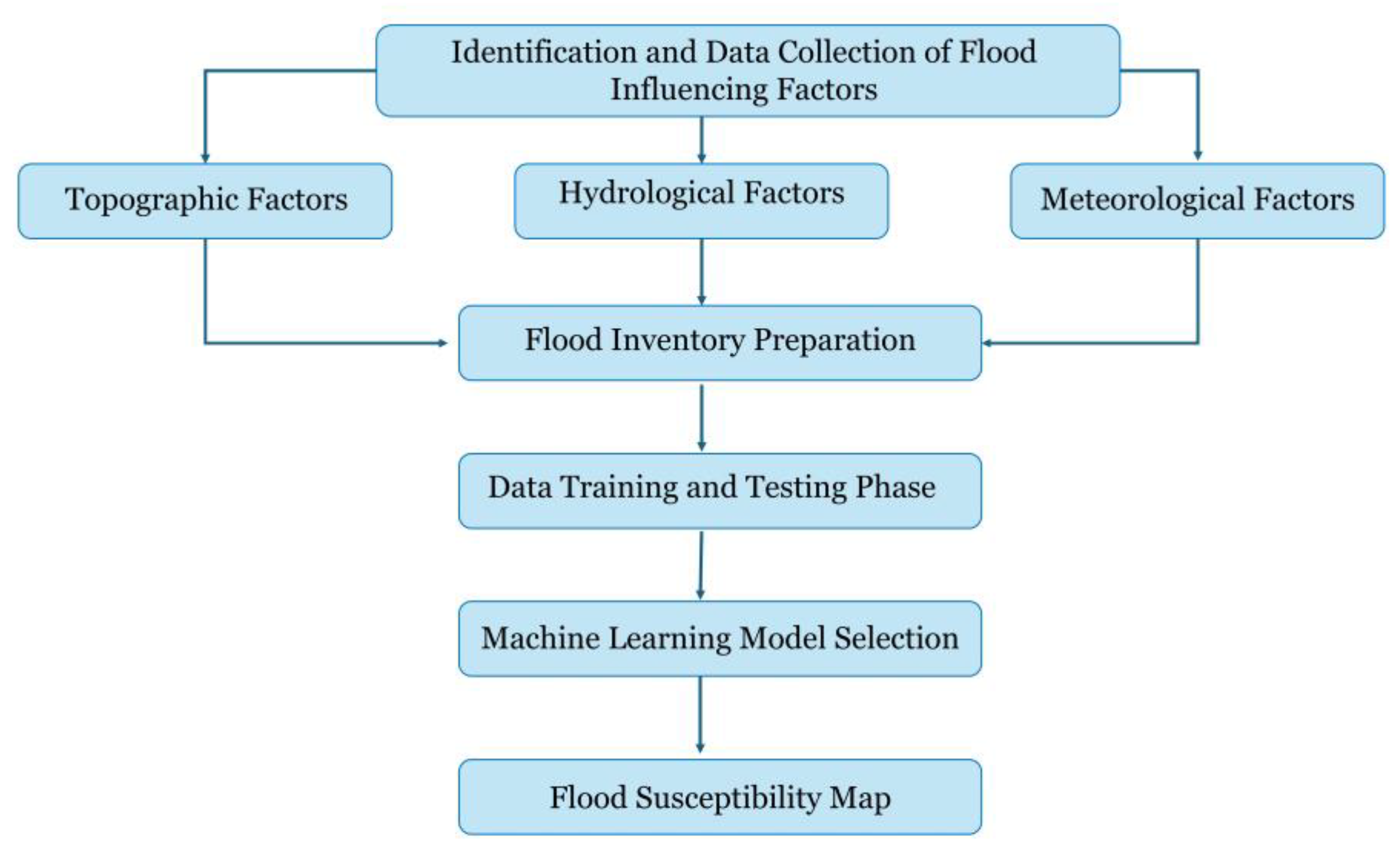



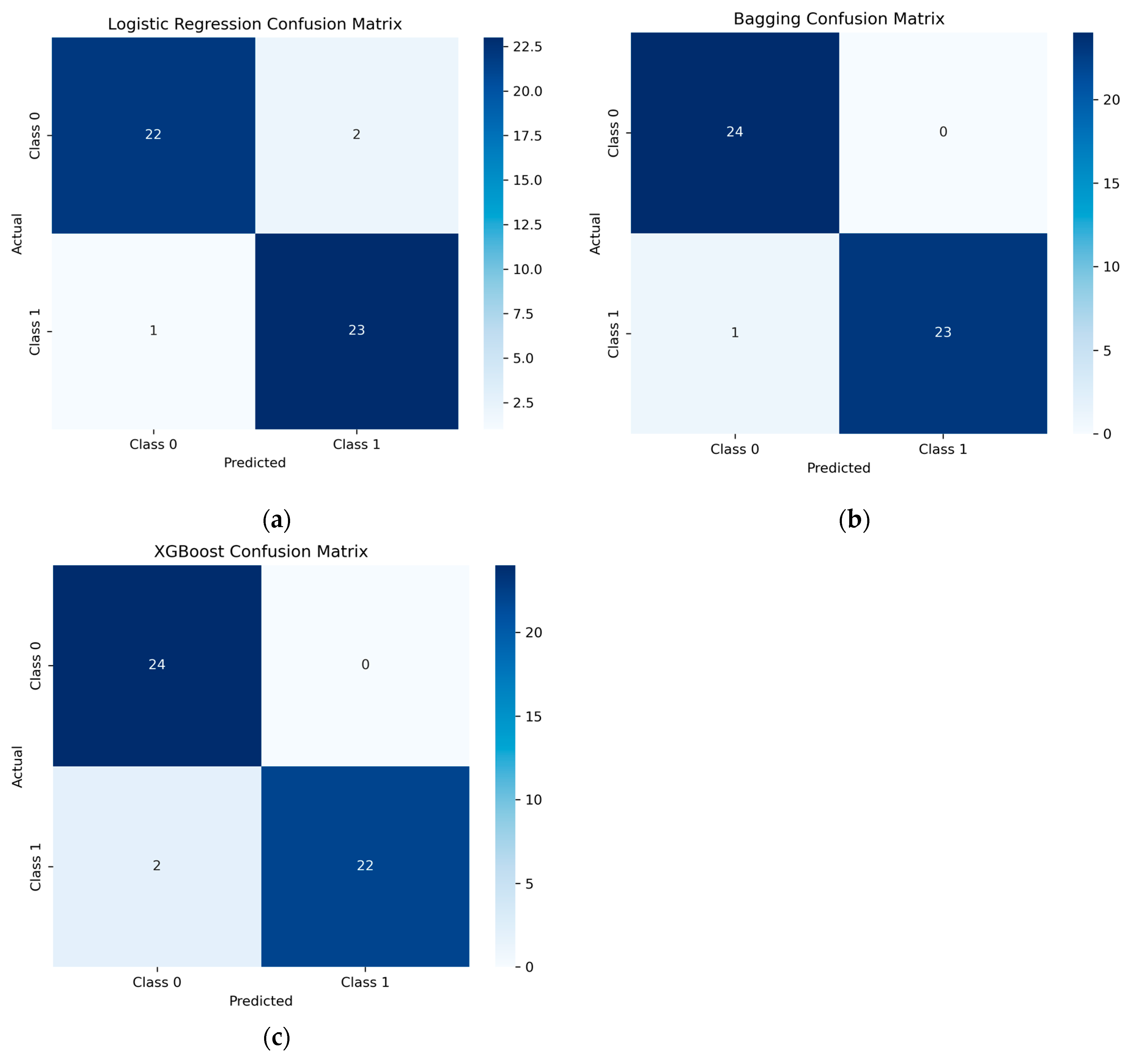
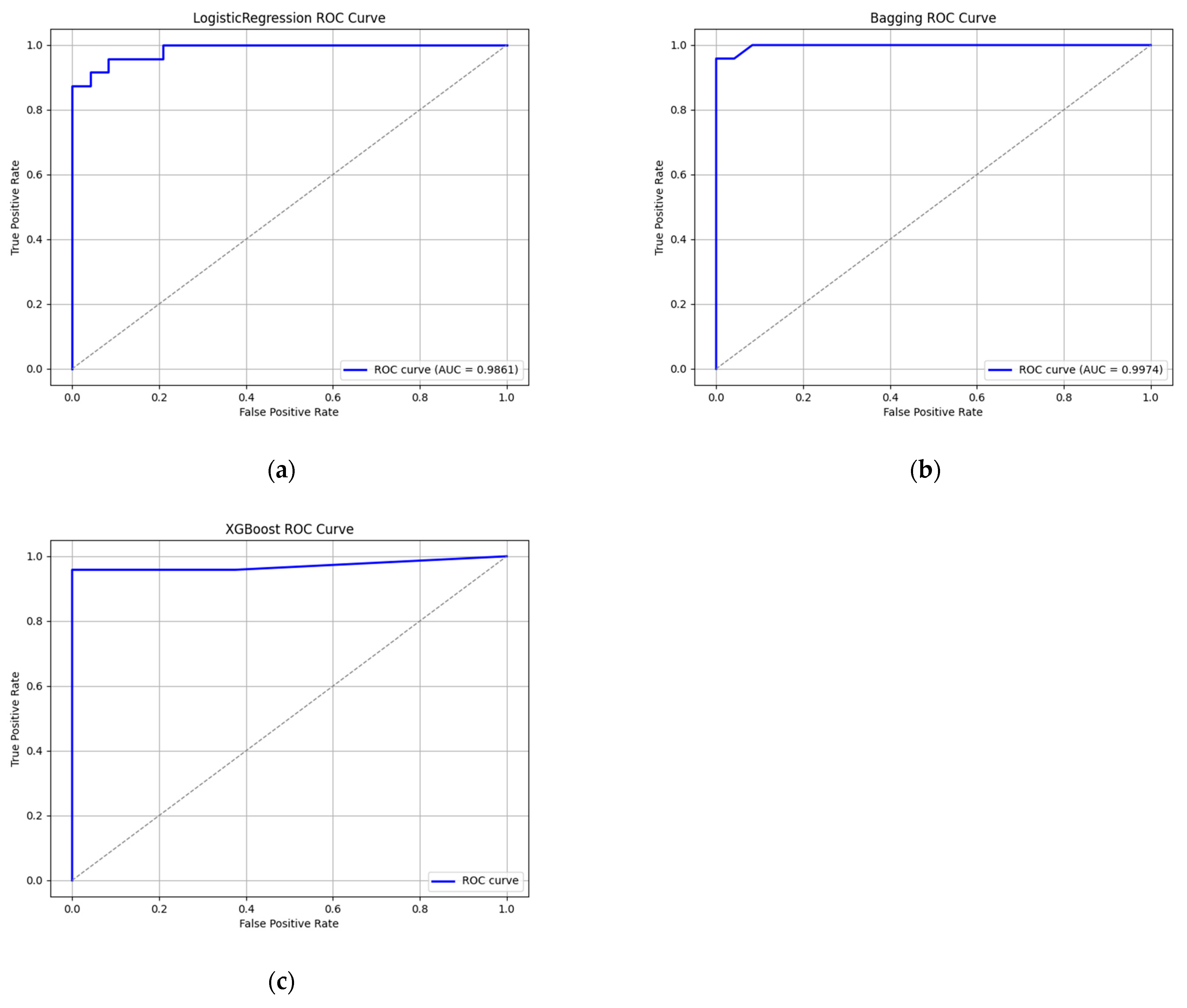
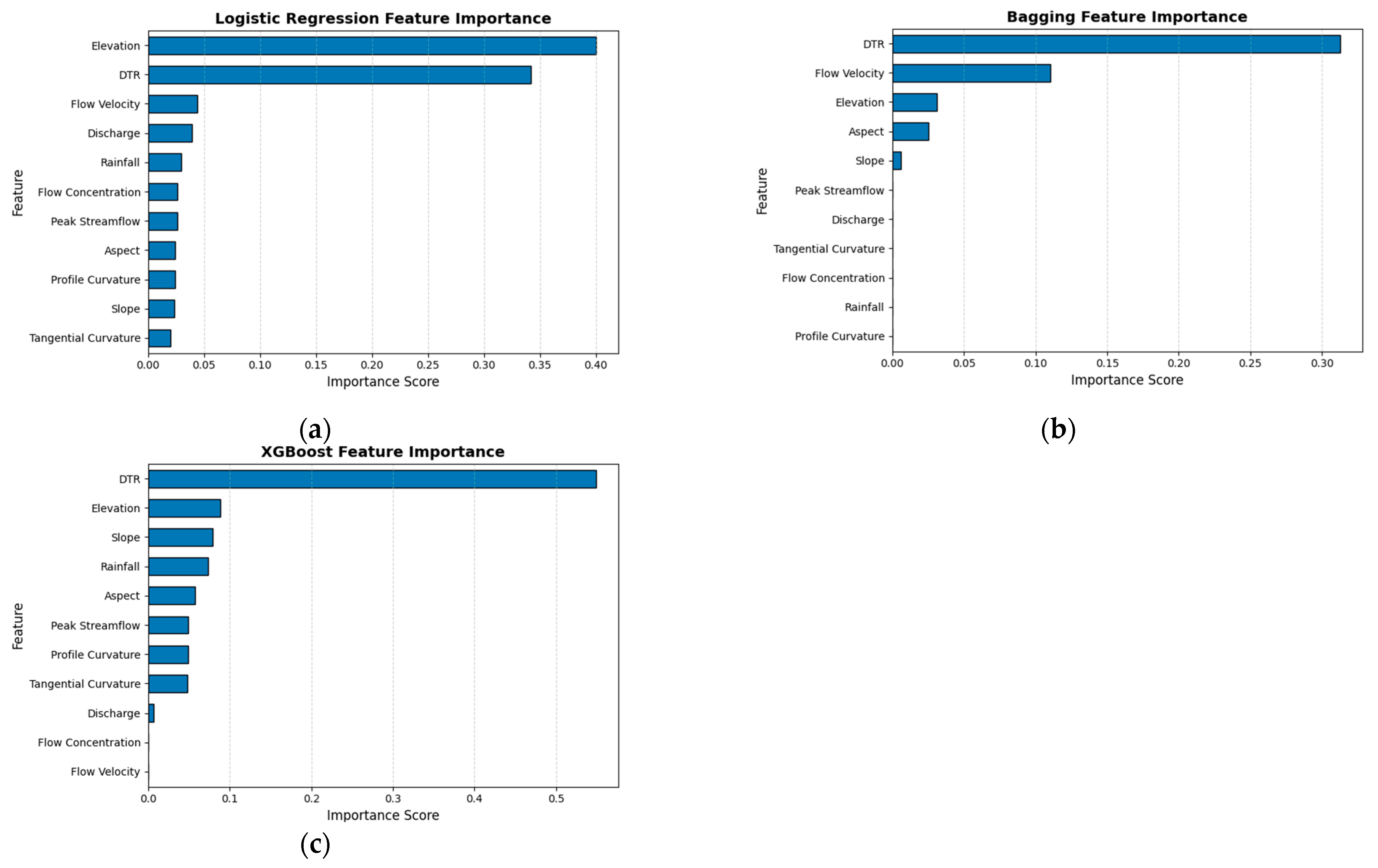
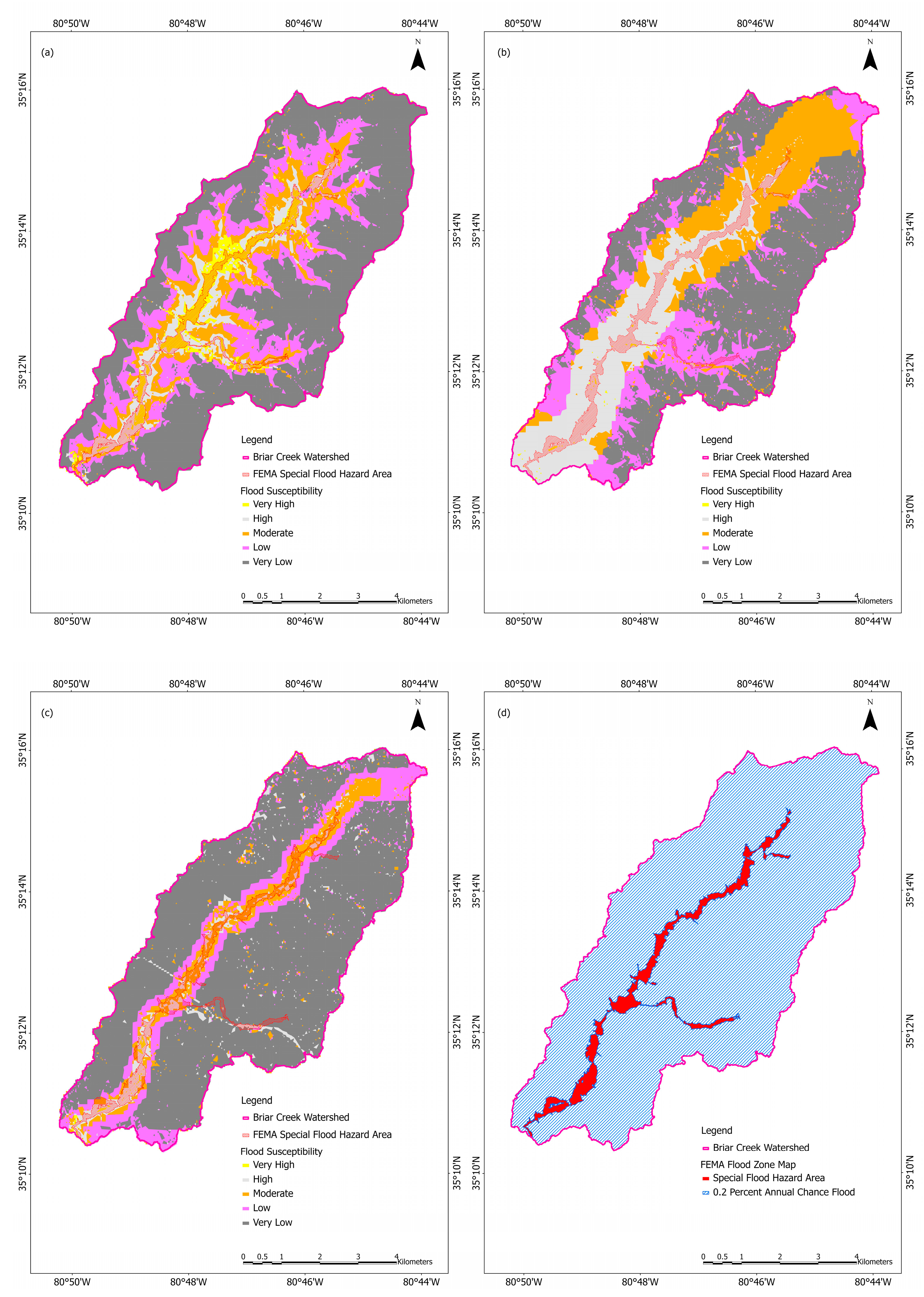
| Data Type | Source | Temporal Coverage |
|---|---|---|
| Digital Elevation Model (1 m) | National Map Viewer—U.S. Geological Survey | 10 October 2024 (Published Date) |
| Land Use/Land Cover (30 m × 30 m) | Multi-Resolution Land Characteristics Consortium | 2019 |
| Precipitation (mm, 5 min interval) | National Water Information System (NWIS) | 1 January 2015–31 December 2022 |
| Streamflow (m3/s, 5 min interval) | NWIS | 1 January 2015–31 December 2022 |
| Soil Data | NRCS Geospatial Data Gateway | 22 October 2024 (Published Date) |
| Model | Hyperparameter | Values Considered |
|---|---|---|
| Logistic Regression | Regularization Strength (C) Penalty Solver | 0.01, 0.1, 1, 10 12 liblinear, lbfgs, saga |
| Bagging | n_estimator max_samples max_features | 50, 100, 150 0.5, 0.75, 1.0 0.5, 0.75, 1.0 |
| XGBoost | n_estimators learning_rate | 50, 100, 150 0.00001, 0.0001, 0.01, 0.1 |
| Model | Accuracy | Precision | Recall | F1 Score |
|---|---|---|---|---|
| Logistic Regression | 0.9792 | 1 | 0.9583 | 0.9787 |
| Bagging | 0.9375 | 0.92 | 0.9583 | 0.9388 |
| XGBoost | 0.9583 | 1 | 0.9167 | 0.9565 |
| Model | Very High Risk (%) | High Risk (%) | Moderate Risk (%) | Low Risk (%) | Very Low Risk (%) |
|---|---|---|---|---|---|
| Logistic Regression | 5.55 | 8.66 | 12.04 | 21.56 | 52.20 |
| Bagging | 0.25 | 22.47 | 19.23 | 18.50 | 39.55 |
| XGBoost | 0.31 | 6.37 | 9.19 | 13.85 | 70.28 |
| Agreement Between Models | Overlapping High-Risk (%) |
|---|---|
| All Models | 1.63 |
| Logistic Regression and Bagging | 5.90 |
| Logistic Regression and XGBoost | 1.76 |
| Bagging and XGBoost | 1.97 |
| Models | Very High Risk (%) |
|---|---|
| FEMA’s Classification | 5.29 |
| Logistic Regression | 5.55 |
| Bagging | 0.25 |
| XGBoost | 0.31 |
Disclaimer/Publisher’s Note: The statements, opinions and data contained in all publications are solely those of the individual author(s) and contributor(s) and not of MDPI and/or the editor(s). MDPI and/or the editor(s) disclaim responsibility for any injury to people or property resulting from any ideas, methods, instructions or products referred to in the content. |
© 2025 by the authors. Licensee MDPI, Basel, Switzerland. This article is an open access article distributed under the terms and conditions of the Creative Commons Attribution (CC BY) license (https://creativecommons.org/licenses/by/4.0/).
Share and Cite
Shrestha, S.; Dahal, D.; Bhattarai, N.; Regmi, S.; Sewa, R.; Kalra, A. Machine Learning-Based Flood Risk Assessment in Urban Watershed: Mapping Flood Susceptibility in Charlotte, North Carolina. Geographies 2025, 5, 43. https://doi.org/10.3390/geographies5030043
Shrestha S, Dahal D, Bhattarai N, Regmi S, Sewa R, Kalra A. Machine Learning-Based Flood Risk Assessment in Urban Watershed: Mapping Flood Susceptibility in Charlotte, North Carolina. Geographies. 2025; 5(3):43. https://doi.org/10.3390/geographies5030043
Chicago/Turabian StyleShrestha, Sujan, Dewasis Dahal, Nishan Bhattarai, Sunil Regmi, Roshan Sewa, and Ajay Kalra. 2025. "Machine Learning-Based Flood Risk Assessment in Urban Watershed: Mapping Flood Susceptibility in Charlotte, North Carolina" Geographies 5, no. 3: 43. https://doi.org/10.3390/geographies5030043
APA StyleShrestha, S., Dahal, D., Bhattarai, N., Regmi, S., Sewa, R., & Kalra, A. (2025). Machine Learning-Based Flood Risk Assessment in Urban Watershed: Mapping Flood Susceptibility in Charlotte, North Carolina. Geographies, 5(3), 43. https://doi.org/10.3390/geographies5030043







